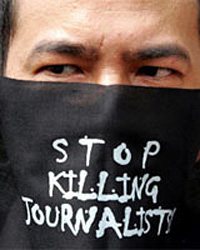 |
 |
 |
 Travel Writers' Resources | April 2007 Travel Writers' Resources | April 2007  
Drug Wars Put Reporters at Risk
 David Ovalle - miamiherald.com David Ovalle - miamiherald.com


| | Mexico has become the second-deadliest country for journalists, after Iraq, as drug traffickers target crime reporters. |
Villahermosa, Mexico - On a recent night, two reporters parked their car in front of the Red Cross station here, the place where they hang out waiting for something to happen. They'd just returned from photographing a minor car wreck.

An official-looking black Ford Explorer, its hazard lights flashing, idled in front.

"Who . . . is that?" the rookie reporter known as Puma wondered. For a second, they stared. Brow furrowed, Puma broke the silence.

"You know, somebody called me yesterday from a blocked number. They told me to quit [messing] around or they were going to [mess] me up," he said quietly.

Moments later, the mystery SUV drove off without incident, but the episode underscored the anxiety that looms over Mexico's crime reporters.

The country's bloody war between drug cartels has provided spectacular stories this year for those who write notas rojas, or so-called red news, as crime reports are known in this sweltering southeastern Mexican city: A severed head hurled at the police station, a police chief wounded in an ambush, an unprecedented flood of Mexican soldiers into the region.

SENSE OF DREAD

But it's also instilled a sense of dread among the tight-knit group of reporters who daily chase auto wrecks, suicides and now the growing violence attributed to drug traffickers. One of their colleagues has been missing since January. Death threats come regularly.

Violence against journalists in Mexico has reached unprecedented levels, as drug cartels wage war over billion-dollar trafficking routes. More than 700 people have died in Mexico in drug-related violence so far this year, the country's national daily El Universal estimates.

In the past year, 10 journalists have been killed, according to Reporters Without Borders, a Paris-based advocacy group. That makes Mexico the second-most dangerous country to be a reporter. First place goes to Iraq.

Hardly a month goes by without violence directed at journalists. Earlier this month, Amado Ramirez, a well-known reporter with the national television network Televisa, was shot dead in a daylight ambush as he left a radio station in Acapulco, on Mexico's Pacific coast. Saul Martinez, a reporter with Diario de Agua Prieta in the northwestern state of Sonora, was kidnapped on April 16 by armed men. He has yet to reappear.

Two days later, somebody lobbed a grenade at another Sonora newspaper, Cambio de Sonora. No one was injured, but the building was damaged.

SCARY CASE

Here in Tabasco state, reporters are haunted by the case of Rodolfo Rincon Taracena, a reporter for the Tabasco Hoy newspaper. A regular at the Red Cross station, Rincon, a father of three, left his newspaper office shortly before 8 p.m. Jan. 20. He hasn't been seen since.

In Villahermosa, the crime reporters meet every day around a white plastic picnic table in the local Red Cross station, which grants them a tiny room to congregate. A TV atop a tiny refrigerator constantly flickers with American movies and news broadcasts.

About 14 reporters from six Tabasco newspapers drift in and out throughout the day.

Some carry hand-held radios to monitor police frequencies.

Mostly, they follow the Red Cross ambulances and rely on tips from sources.

"I'd rather have a million friends than a million enemies," Felipe Rosales, 30, a veteran reporter from the daily Novedades de Tabasco, likes to say.

To be sure, competition exists among the reporters, but mostly they share tips, give each other directions to crime scenes and ride in the same cars.

When threats arrive, they endure together.

Last fall, someone shot up a police commander's car. No one was hurt. The gunman's car was found abandoned nearby.

Inside, a note in Spanish was found: "This is what happens to those who get involved in the drug sales. Why do reporters care?"

"It really made us think. If you see they can kill a police officer, think about what they could do to us," Rosales said.

dovalle@miamiherald.com
Police Find Body of Abducted Mexican Editor
Associated Press

Hermosillo, Mexico - Mexican police say they've found the body of a newspaper editor abducted last week outside a police station in the border city of Agua Prieta.

A state official in Sonora says the body of Saul Noe Martinez Ortega, an editor at the Interdiario de Agua Prieta, was found in neighboring Chihuahua state.

Thirty-six-year-old Martinez Ortega was abducted April 16th by men armed with assault rifles who forced him into a car in the center of the city, across from Douglas.

The Mexican official says Martinez Ortega had been dead at least six days and relatives identified his body by a tattoo on his right shoulder. | 
 | |
 |



